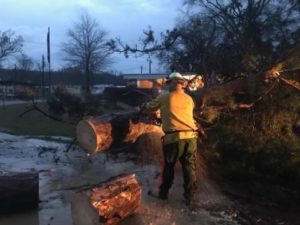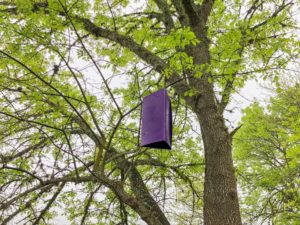Step into the fire with Jason Jones
A week in the life of Jason Jones, Texas A&M Forest Service resource specialist
Near midnight March 17, Jason Jones’s cell phone rang.
Now, given the nature of his job as a resource specialist at Texas A&M Forest Service, it was not unusual for him to receive emergency calls after hours, especially when Texans need him the most.
Jones’ boss updated him and requested his help with wildfires burning across Eastland County. As it turned out, several of those fires would later become part of the Eastland Complex wildfire that quickly grew to a blaze that burned over 54,500-acres, destroying over 100 structures along its path.
Five hours after the initial phone call, Jones’ was packed with 14 days’ worth of personal protective equipment and a cooler full of groceries. Dozers, all-terrain vehicles and equipment were loaded and ready, and Jones and his crew drove four hours west to Eastland County.
Upon arrival, Jones and his crew connected with the incident commander and were immediately set on their task of constructing containment lines with dozers along the northeast section of the Kidd Fire, one of the several fires within the Eastland Complex. For the next four days, they worked to contain the flames of the quickly growing wildfire.
Jones serves as a resource specialist IV for Texas A&M Forest Service in Northeast Texas. He began his career with the agency in 1999 as a seasonal firefighter, and within a year was hired on full-time to work as part of the Forest Inventory and Analysis, FIA, program. After he finished working for the program in 2004, Jones waited patiently until a position as a resource specialist I opened in Linden in 2009. Over the last 13 years, he has worked his way up to a level IV specialist within the agency.
“I grew up with my dad running equipment in the logging and forestry industry,” said Jones. “I had seen and known about the forest service throughout my life, and when that first position came up, I thought ‘hey, I would love to work for them’.”
After a nearly 20-year career with the agency, the week of March 17-24 was typical for Jones.
Battling wildfires
On the afternoon and evening of March 17, the Eastland Complex was showing extreme fire behavior, which makes any efforts by firefighters an incredible challenge. But Jones and his crew were equipped with years of experience and training.
Firefighters observed group torching, which is the transition of fire from the ground to tree canopies, in oak and juniper timber up to 150 yards away from the active fire.
With extreme fire behavior like this, one of the best lines of defense is to create a fire line on the ground with heavy equipment – a barrier around the fire scraped or dug down to the soil so the fire has no fuels to continue.
Positioned in a dozer Friday afternoon, Jones responded to a blaze moving through the woods toward nearby homes. He moved quickly to establish strong fire lines to protect homes and property.
“We had one section tied in pretty good, so we began heading back to another part of the fire,” said Jones. “Then we turned around and watched the fire blow up behind us through a coastal hay field, so the dozers just took off towards it. I caught one pasture and another dozer that was with me went across the road to a neighboring pasture. In the middle of that, luckily the planes started dropping for us and cooling the fire off.”
After those rapid response efforts, Jones and his crew went back to work at the head of the fire, which became a substantial challenge due to the rough terrain that included rocks, ledges, 30-foot drop-offs and crossing a river. Over the weekend, Jones and his crew began each day at 5 a.m. by attending a fire briefing before getting on dozers to fight the fire with more fire lines.
“Each day starts with a briefing where everyone meets and we talk about everything – the weather, safety, what the fire is doing, the wind for the day, just everything and cover all the bases,” said Jones. “Then they give us our incident action plan, or IAP, paperwork that has everything detailed in it so you can carry it with you to do your work for the day.”
Jones would shut down around 10 p.m. after a long day on the dozer and navigating potential new fire threats to find something to eat, get some sleep and do it all again the next day.
On Monday, the wildfire received much-needed rain and the Southern Area Gray Team arrived to help manage the fire, releasing Jones and his crew back to their home base. They made it home at 8 p.m., where they serviced their equipment and made sure it was ready for a new day’s work if needed.
Responding to storms

When Jones arrived home on Monday, he looked forward to sleeping in his own bed after days on the fire line, but his phone rang at 11 p.m. That day 27 tornadoes hit parts of Central and East Texas as severe weather pushed through the state. One had touched down in Cass County, and his assistance was needed to help clear debris.
“The fire department called telling us that trailer houses were turned upside down, trees were in the road, debris was across major highways,” said Jones. “So, we got a saw crew together and went out to help clear out the storm damage.”
Local fire departments, county officials and community members were already hard at work when they arrived, but more help was needed to cut up and remove larger, fallen trees from roadways.
“There was one woman trapped in her home that had flipped over,” he said. “She wasn’t hurt but just couldn’t get out. Our job is to clear the way for the fire department to get to victims like that.”
The Texas A&M Forest Service is called on for any hazardous event or disaster, including tornadoes, hurricanes, COVID-related responses and more. While Jones and the saw crew stayed out until 5 a.m. Tuesday morning assisting in debris removal from the storm damage, other offices across East Texas assisted with similar debris clean up and structure damage assessments for counties in need.
Managing forests

Upon return to the office Tuesday morning and for the remainder of the week, Jones helped set Emerald Ash Borer, EAB, traps across Linden and Cass counties. The EAB is an invasive species that targets ash trees and has killed millions of trees across North America over the past two decades. Ash trees provide shade to many yards in the U.S., and specifically, the wood of ash trees is used in furniture, cabinetry, tool handles and most famously as the primary wood for baseball bats and hockey sticks.
The insects were first discovered in Texas in 2016, and the Texas A&M Forest Service has been tracking their spread by hanging traps across the state. Each trap uses an oil to attract and lure the beetles in, and when they land, the bugs stick to the adhesive glue that lines the surface.
Each year, Jones helps set these traps by finding ash trees and carefully hanging the large, sticky, purple traps.
After a long day of setting EAB traps, Jones received another wildfire request Thursday evening in East Texas. After five hours helping contain the flames into the night, Jones woke up Friday morning to set more EAB traps.
“It’s just like putting on a different hat every day,” said Jones. “Some days you’re a forester and some days you fight wildfires, and some days you do both.”
From wildfires in Central Texas, to tornadoes and storm clean-up in East Texas, to forestry work and back to wildfires again – it’s all in a week’s work for Texas A&M Forest Service personnel as they stand ready to conserve, protect and serve Texas.



